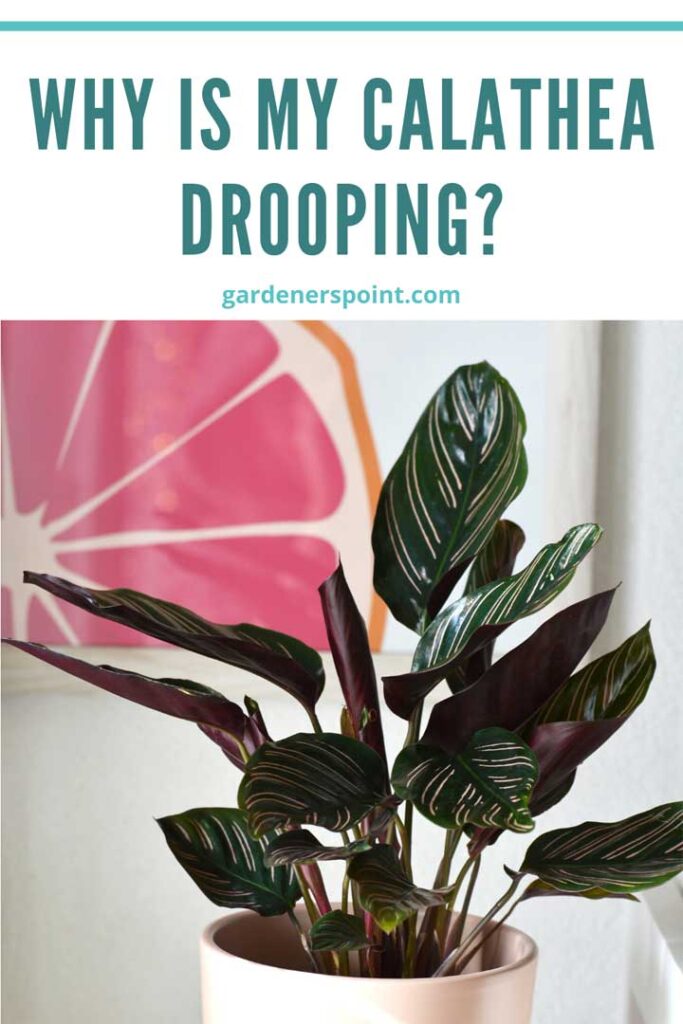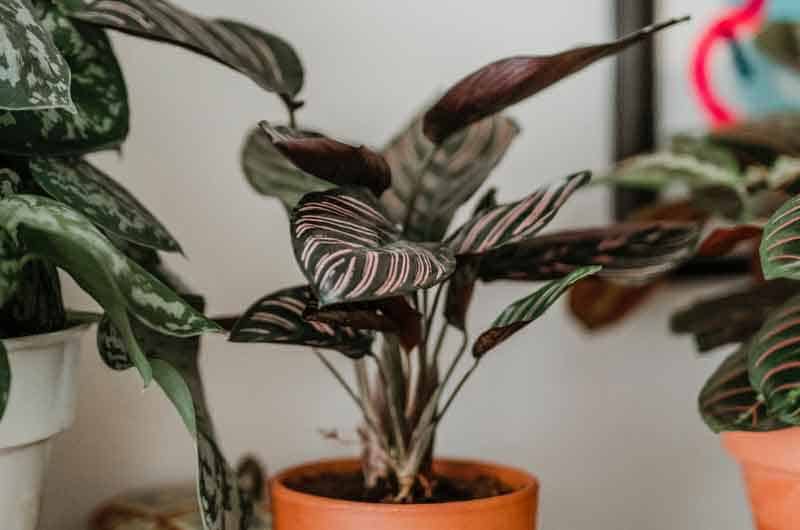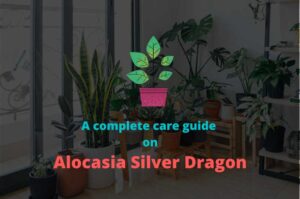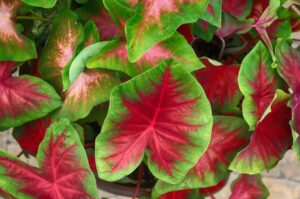Why Is My Calathea Drooping? (Causes and Solutions)
Calatheas are the most beautiful houseplants specifically used for home decorations. However, they have a reputation for drooping owing to different problems. In case your Calatheas are drooping, worry not, as in this article we are going to solve your queries about why is your Calathea plant drooping.
The most important reasons for which your Calathea plant is drooping are overwatering and underwatering. Apart from this temperature stress, over-exposure to the sun, over or underfeeding, bad water quality, and low humidity levels are some of the main causes of drooping leaves in Calatheas.
This article will be a guiding light for you to solve the problems related to your drooping Calathea plant. Also, there will be solutions to how you can nurse them for better health.

The Causes of a Dropping Calathea
The genus Calathea encompasses some of the most beautiful tropical plants present in the world. One can easily recognize the plants by their oval-shaped leaves and ravishing display of colors.
Characterized by its eye-catching stripes and patterns of veining, the plants earned several nicknames such as peacock plant, zebra plant, and rattlesnake plant.
These plants are native to Brazil and grown indoors throughout the year, the plants earned a reputation of being fussy for their growth conditions. The plants in their natural habitat enjoy moist and highly humid temperatures that remain consistent throughout the year.
Calatheas never faced diverse climatic conditions in their natural habitat, and hence, need to struggle when presented with imperfect conditions.
If you find the reason behind the dropping of your Calathea, pay more attention to your plant and think about the climatic conditions your plant experienced recently.
We will explain each of the common reasons that might lead to the drooping of Calathea. Thereby, we will explain the symptoms towards which you need to pay attention for fixing the problems.
The solutions would help you in solving the problems persisting with your plant and nurse it so that it retains back to its health.

Underwatering
Similar to all indoor plants used for decorating houses and offices, Calatheas need a very specific amount of water for staying healthy. If you seldom water your plants, the leaves are likely to become dry and start to discolor and curl. If you want to find the water that has the right balance, water your plants with little water regularly.
Various factors will cause your lovely Calathea plant to use more water or cause wilting and drooping due to lack of water.
Hot weather: With the consistent rise in the temperatures, accelerates evaporation of water from the soil and transpiration from the leaves.
Becoming Rootbound: If your Calathea becomes rootbound, it will fill the entire pot and will require more water, which prevents it from wilting and drooping.
Improper Watering: Ensure your plants gets proper hydration. For this, it is important to soak the soil and roots while watering.
Fixing a Calathea Drooping Due to Underwatering
If your Calathea starts drooping due to underwatering, it will recover to its former condition without experiencing huge damage. However, prolonged or repeated underwatering is likely to cause major problems and even lead to the death of the plant.
The best thing that you can do is to check the plant every two to three days. Feel the soil and look at the foliage. Do not water the plant if you find the top layer dry. Test the dryness of the soil by poking a finger and find if the deeper layer is moist.
If not, water the plants not exceeding a couple of days. While you water the plants, ensure that you drain off the excess water and avoid the presence of roots in waterlogged soil.
Overwatering
Although underwatering is the main cause of Calathea dropping, yet you need to pay attention to overwatering. Calathea have delicate roots, which requires consistent access to lightly moist conditions for supplying enough water for sustaining the plants.
Besides, the plant’s roots need oxygen for survival, and if the soil is waterlogged oxygen fails to reach the roots, making it sticky.
Anaerobic bacteria grow well in waterlogged soils, which further attacks the weak roots of the plants. The bacteria in the roots cause the roots of the plants to rot and cause trouble with your plant.
Examine your plants carefully to find the following symptoms to assess the cause of Calathea drooping due to overwatering.
- Yellowing of lower leaves, but spreads upwards if things get worse.
- Browning of the tips of leaves occurs if the roots start to rot. The tips of the leaves are first to suffer and die after they turn brown.
- Looking for wilting of the foliage despite the presence of water in the soil.
- You might see the curling of the leaves, which try to take in more water due to dysfunction of the roots.
- Examine the offensive smell that might come from the soil around your Calathea plant, which is a prominent sign of rotting of the roots.
Fixing a Calathea Drooping Due to Overwatering
There are two steps in saving your drooping Calathea- treating the roots and repotting them.
With gentle hands, remove the plant from its pot and observe the roots well. Use sterile pruners or garden scissors for removing the rotten roots. Black, mushy and unpleasant smells from the root are symptoms of rotten roots.
Keep the healthy roots and remove the soils around them. Remove them with your hands and wash off the excess soil gently. Alternatively, you can dip the roots in a dilute solution of hydrogen peroxide. You can also sprinkle a little amount of cinnamon powder. These will eliminate the existing pathogens from the roots.
Now repot the plant in a bigger pot and use a well-drained potting mixture. Make sure that you are using a pot with proper drainage holes. However, if you need to prune most of the roots, prune out a similar amount of foliage also. A plant having less root will not support a large amount of foliage. Now place the new pot in bright indirect light and with a high level of humidity.
Your Calathea will grow new in a couple of months. It will start developing healthy roots before producing any new foliage. With good conditions for its growth, your Calathea will recover over time.
You may also like- Why Is My Calathea Not Growing New Leaves?
Temperature Stress
If you find brown edges and tips on the Calathea leaves despite the growth conditions that meet all the requirements, then temperature stress might be the underlying cause. Calatheas thrives the best in temperatures between 64⁰F and 75⁰F (18⁰C and 24⁰C).
However, they can thrive well in warmer temperatures as long as the environment has high humidity. Temperatures below 60⁰F (15⁰C) will result in stressing of the plants and further temperatures lower than 50⁰F (10⁰C) might cause the death of the plant.
Remain careful from the drafts of the doors and windows, vents of air conditioners, radiators, and other heat sources, as these cause severe fluctuations in the temperature causing rapid deterioration of the plants. The plants might become yellow or brown, start to wilt, droop, and even bring death to your Calathea.
Fixing a Calathea Drooping Due to Temperature Stress
Purchasing Calathea from the store or delivering the plant might lead to temperature stress. Try to control the temperature while you are bringing it home and place it in a suitable location at the earliest. Place the plant where the temperature remains consistent.
It is advisable to use a thermometer to monitor the temperature of the room. If you find that the plant experiences extremes of temperature, move it to a spot before causing any damage.
Low Humidity Levels
While overwatering results in the quickly dying of your Calathea plant, low levels of humidity cause the slow demise of your beautiful plant. These plants absorb moisture through their wide leaves, and if the air is dry, the leaves start curling and change their color from green to yellow.
Calatheas cannot bear humidity levels below 40% and even some plants show damage signs when the humidity drops below 60%. You might notice a rough or brittle texture on the leaves. You might also notice that the edges of the leaves start breaking when touched. Prolonged exposure to low humidity might result in the death of the plant.
Fixing a Calathea Drooping Due to Low Humidity Levels
Your Calathea plant will require an immediate burst of moisture. Use a spray bottle in its lightest settings for misting the leaves of your plant. Never use direct streams of water, as it might cause severe damage to the plant, especially if the leaves are delicate. Misting the plants provide moisture between two to four hours.
Although it is not a long-term solution, yet regular misting of your Calathea will help revive itself while you correct the humidity in its environment.
Use humidifiers for creating a humid environment. You can use desktop humidifiers and place them near the plants. Turn it on and off as required to create a perfect environment.
Alternatively, you can use a humidity tray filled with water near the plant. The evaporation of water from the tray will increase the humidity of the environment.
Overexposure to Sun
In the wild, the Calatheas grow beneath the canopies of tropical rainforests. While you grow these plants at home, remember to place them in the shade where the light is low. Placing the plants in direct sunlight will result in fading of the leaves and might remove the beautiful white and green markings.
If the plants receive more light, they will curl their leaves. However, if you move it back to the shade, the plants must unfurl their leaves within a couple of days.
Fixing a Calathea Drooping Due to Over Exposure to Sun
Rather than placing your Calathea in direct sunlight, find a shady spot in your home that receives moderate and ambient room light. Calatheas grow and thrive well in indirect sunlight.
You can place your plant in a north-facing window. You will notice that the leaves move to receive extra sunlight. If you fail to find a shady spot in the house, place an obstruction between the light and the plant. The obstruction will avoid the scorching of the leaves.
You may also like- Is my plant getting too much light? Can too much light kill a plant?
Natural Shedding of Lower Leaves
While some household plants require a lot of pruning, your Calatheas does not need to undergo a lot of pruning. With the aging of the leaves, they will turn yellow or brown and then die.
Fixing a Calathea Drooping Due to Natural Shedding of Lower Leaves
Trim off the dead leaves with a pair of sterilized sharp scissors. Cut off the leaves from where they join with the stem or from the soil level. If you love to maintain and more compact and bushy growth, your Calatheas needs regular pruning.
You cannot help if your plants droop due to the shedding of the lower leaves, as it is a natural process. Examine whether the fresh growth is healthy. If it is so, you are moving on the right path.
Transplanting Stress
Calatheas are very sensitive houseplants and hate that their roots are disturbed unnecessarily. Transplanting stress not only results in drooping of the Calathea plants but also causes death to the plants in some cases.
If you find your Calathea plants start to droop or wilt within the first few days post repotting, then transplanting stress is the only cause. The roots temporarily start to cease functioning and insufficient water causes dehydration in the plant.
Fixing a Calathea Drooping Due to Transplanting Stress
- Do not repot your Calathea plant unless you find symptoms of rootbound. Do not disrupt the root ball unless it is necessary.
- You can increase the size of the pot by one to two inches while repotting and add some extra soil around the rootball.
- If you find your Calathea suffering from transplanting stress, reduce the water loss from the soil while the roots recover themselves.
- Increase the humidity as much as possible.
- Avoid the development of extremes of temperatures and lighting around the plant. This will help the Calatheas roots to recover.
Remember, Calatheas do not always recover from transplanting stress, but these simple measures will help the plant to survive.
Water Quality
Dropping and curling of Calathea leaves is a sign of distress. However, you might fail to identify the problem easily. An overabundance of minerals present in the source of water is one of the common and prominent causes of drooping and sick Calathea plants.
Fixing a Calathea Drooping Due to Water Quality
Tap water often contains high levels of salt, resulting in wilting and fading of Calathea plants. Examine your plant and take a note, whether it is suffering from a hard water problem. If so, you will find yellow edges on the leaves and deposition of salt on the surface of the soil.
Replace tap water with distilled water or bottled water. You can also collect rainwater and use it for watering the plants. Use water that is at room temperature and do not water too much at once.
Over or Underfeeding
Calatheas require very little fertilizers for their growth. Overfeeding might cause drooping, yellowing of leaves, and other issues. The plants typically grow during the summers and spring. Hence, you need to feed the plants during these seasons.
The plants do not require feeding during the winter months, as there is not much growth. However, you need to maintain watering the plants, so that they do not dry. If you have a small plant, you need to feed it more often. Ensure that it receives enough nutrients for its healthy growth.
Fixing a Calathea Drooping Due to Improper Feeding
Sometimes fertilizer residues build upon the soil, resulting in yellowing and drooping of the plants. This occurs mostly due to partial watering or due to “topping off”. Hence, always water until a stream exits the drainage hole. Flush the soil every few months for maintaining the freshness of the soil.
You can add a teaspoon of kelp fertilizer to half a gallon of distilled water, which is a gentle organic regimen. Use the mixture once every month. Do not pour the entire mixture all at once. Fertilizers are not medicines. It helps in the healthy and active growth of the plants. If your Calatheas droop after feeding, you can increase the dilution or reduce the frequency.
The Takeaway
Although Calatheas come with plenty of challenges in terms of maintaining their health and growth, yet they are beautiful houseplants worth the effort to keep them in the best shape and conditions.
If you observe your Calatheas well, you can identify the problems yourself. Even you can fix these problems hassle-free before causing major damage to the lovely plants. However, if you still have issues in identifying any problem or solving the problem, you can visit our blogs for further help.






